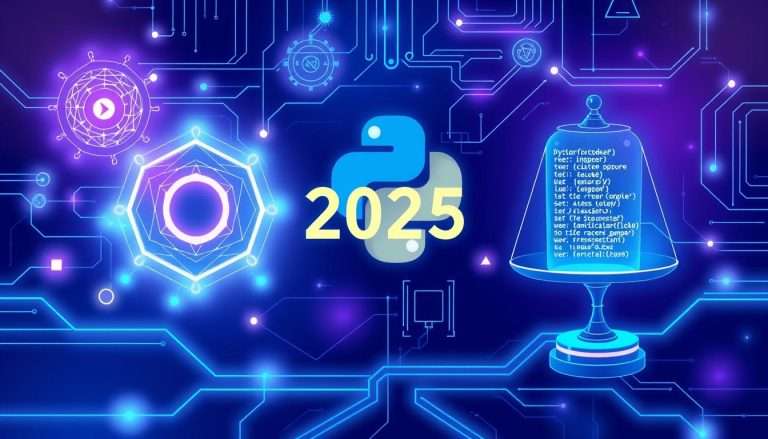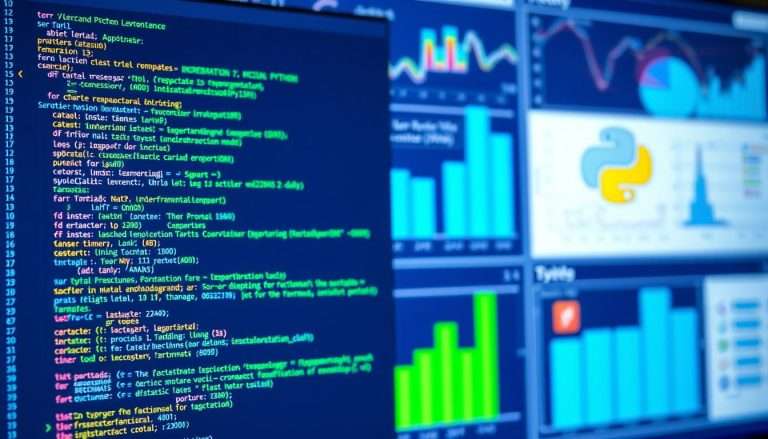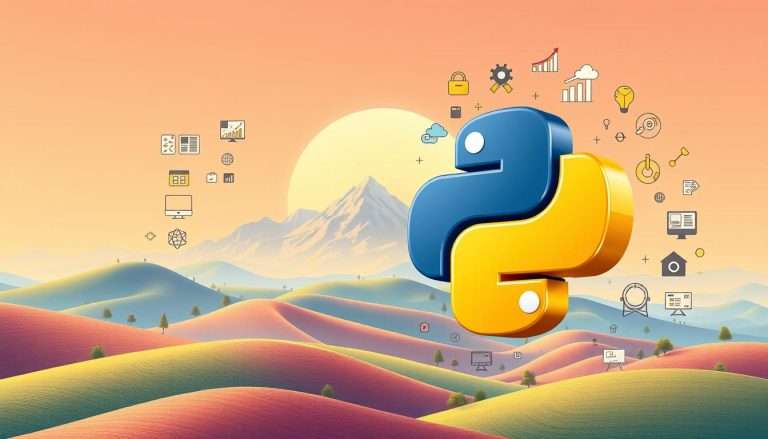Why You Should Learn Python in 2025?
In 2025, the tech landscape continues to evolve, and Python remains at the forefront as a best programming language. Its simplicity, versatility, and the vast number of libraries make it an ideal choice for beginners and experienced developers alike.
Whether you’re interested in data science, machine learning, or web development, learning Python opens doors to numerous career opportunities. Its widespread adoption across industries ensures that the skills you acquire are relevant and in demand.
Key Takeaways
- Python’s simplicity makes it an ideal language for beginners.
- Its versatility supports a wide range of applications, from data science to web development.
- Learning Python can significantly enhance your career prospects in the tech industry.
- Python’s extensive libraries and frameworks simplify the development process.
- It’s a highly sought-after skill in the job market.
The Rising Dominance of Python in the Programming World
In the ever-evolving landscape of programming languages, Python has emerged as a clear frontrunner, gaining widespread acceptance. Its simplicity, flexibility, and extensive libraries have made it a favorite among developers and industries alike.
Python’s Growth Trajectory Since 2020
Since 2020, Python’s popularity has seen a significant surge. According to various indices, Python has consistently ranked among the top programming languages. This growth can be attributed to its adoption in emerging technologies like Artificial Intelligence (AI) and Machine Learning (ML).
Current Popularity Rankings Among Programming Languages
As of 2025, Python holds a top position in programming language rankings. Its versatility and ease of use have contributed to its widespread adoption across different domains, from web development to data science.
Why Python Continues to Gain Traction in 2025
Python continues to gain traction due to its extensive community support, rich ecosystem of libraries, and its ability to adapt to new technologies. As technology advances, Python’s relevance and popularity are expected to endure.
Why Python is the Best Programming Language for Beginners
For those new to programming, Python stands out as an ideal starting point due to its simplicity and versatility. This makes it an excellent choice for beginners looking to learn programming.
Simplified Syntax and Readability
One of the primary reasons Python is considered beginner-friendly is its simplified syntax. Python’s syntax is designed to be easy to read and write, with a focus on readability. This reduces the learning curve for new programmers, allowing them to focus on programming concepts rather than complex syntax.
Extensive Documentation and Community Support
Python’s extensive documentation and community support are crucial for beginners. The official Python documentation is comprehensive and easy to navigate, providing detailed explanations and examples. Additionally, Python’s community is vast and active, offering numerous resources, including tutorials, forums, and libraries.
Versatility Across Different Applications
Python’s versatility is another significant advantage for beginners. It can be used in various applications, from desktop applications to web development and data analysis and visualization.
Desktop Applications
Python can be used to create desktop applications with ease, thanks to libraries like Tkinter and PyQt. These libraries provide a simple way to build GUI applications, making it an excellent choice for beginners looking to build desktop applications.
Web Development
Python is also widely used in web development, with popular frameworks like Django and Flask. These frameworks provide a structured approach to building web applications, making it easier for beginners to learn web development.
Data Analysis and Visualization
Python is a popular choice for data analysis and visualization, thanks to libraries like Pandas, NumPy, and Matplotlib. These libraries provide efficient data structures and operations, making it easy to analyze and visualize data.
| Application | Python Libraries/Frameworks |
|---|---|
| Desktop Applications | Tkinter, PyQt |
| Web Development | Django, Flask |
| Data Analysis and Visualization | Pandas, NumPy, Matplotlib |
The Expanding Job Market for Python Developers in 2025
As we step into 2025, the job market for Python developers is witnessing unprecedented growth. The versatility and efficiency of Python have made it a favorite among developers and companies alike, leading to a surge in demand for skilled professionals.
Salary Trends and Projections for 2025-2030
The salaries for Python developers are expected to continue their upward trend through 2025 and beyond. According to industry reports, the average salary for a Python developer in the United States is projected to increase by 15% by 2030.
Salary Projections:
| Year | Average Salary | Projected Increase |
|---|---|---|
| 2025 | $120,000 | – |
| 2027 | $135,000 | 12.5% |
| 2030 | $160,000 | 18.5% |
Most In-Demand Python Roles
Python developers are sought after for various roles, including data scientists, machine learning engineers, and backend developers. The demand for these roles is driven by the growing need for data analysis, AI, and web development.
- Data Scientist
- Machine Learning Engineer
- Backend Developer
- DevOps Engineer
Industries Hiring Python Developers
Python developers are in demand across various industries, including tech, finance, healthcare, and more.
Tech and Software Development
The tech industry remains the largest employer of Python developers, with companies like Google and Facebook using Python extensively.
Finance and Banking
Financial institutions are leveraging Python for data analysis, risk management, and algorithmic trading.
Healthcare and Biotechnology
Python is used in healthcare for data analysis, medical research, and developing healthcare applications.
The job market for Python developers is not only expanding but also diversifying across industries. As Python continues to be the best programming language for various applications, the demand for skilled Python developers is expected to remain high.
Python’s Role in Artificial Intelligence and Machine Learning
In the rapidly advancing fields of AI and ML, Python stands out as a crucial tool. Its extensive range of libraries and frameworks makes it an ideal choice for developers and researchers alike.

Key Python Libraries for AI/ML Development
Python’s popularity in AI and ML can be attributed to its powerful libraries, including TensorFlow and PyTorch, which are widely used for building and training machine learning models.
Other significant libraries include Scikit-learn for general machine learning tasks and Keras for deep learning.
Real-World AI Applications Built with Python
Python has been instrumental in developing various AI applications, from virtual assistants to self-driving cars.
For instance, companies like Google and Facebook rely on Python for their AI-driven services, showcasing its scalability and versatility.
How Python is Shaping the Future of AI in 2025
As AI continues to evolve, Python’s role is becoming even more critical. Its simplicity and the extensive community support make it an attractive choice for new AI projects.
Large Language Models and Python
Python is at the forefront of developing large language models, with frameworks like Transformers enabling the creation of sophisticated language models.
Computer Vision Advancements
The field of computer vision is also benefiting from Python, with libraries like OpenCV providing comprehensive tools for image and video processing.
Predictive Analytics Evolution
Python’s Pandas and NumPy libraries are crucial for data manipulation and analysis, driving predictive analytics forward.
As stated by Andrew Ng, “AI is the new electricity,” and Python is the conduit through which this electricity is being harnessed.
“AI is the new electricity. Just as electricity transformed numerous industries, AI will do the same.”
Data Science and Analytics: Python’s Stronghold
The dominance of Python in data science and analytics is attributed to its simplicity, flexibility, and the vast ecosystem of libraries it supports. This has made Python an indispensable tool for data professionals worldwide.
Python vs. Other Data Science Languages in 2025
Python’s popularity in data science can be gauged by comparing it with other languages like R and Julia. While R is renowned for its statistical capabilities, Python’s broader application range and ease of use give it a significant edge. Julia, though promising, still lags behind Python in terms of community support and library availability.
Key advantages of Python over other data science languages include:
- Extensive libraries such as Pandas, NumPy, and scikit-learn
- Simplified syntax that enhances readability and reduces development time
- A vast and active community that contributes to its growth
Essential Python Tools for Data Scientists
Data scientists rely on a variety of Python tools to perform their tasks efficiently. Some of the most essential tools include:
- Jupyter Notebooks for interactive computing
- Pandas for data manipulation and analysis
- Matplotlib and Seaborn for data visualization
- Scikit-learn for machine learning tasks
Career Opportunities in Python-Based Data Analysis
Python’s versatility in data analysis has opened up numerous career opportunities across various sectors. Some of the key areas where Python skills are in high demand include:
Big Data Processing
Python is used extensively in big data processing frameworks like Apache Spark, enabling professionals to handle large-scale data processing tasks.
Business Intelligence
Python’s data analysis capabilities are utilized in business intelligence to drive decision-making processes through data-driven insights.
Scientific Research
In scientific research, Python is employed for data analysis, simulation, and visualization, facilitating groundbreaking discoveries.
By learning Python, individuals can significantly enhance their career prospects in the field of data science, tapping into a wide range of opportunities across different industries.
Web Development with Python in 2025
With its extensive range of frameworks and tools, Python remains a top pick for web development projects in 2025. The language has evolved to accommodate the changing needs of developers and businesses alike, making it an ideal choice for building robust and scalable web applications.
Modern Python Web Frameworks
Python’s web development landscape is dominated by modern frameworks that simplify the development process. Django and Flask are two of the most popular frameworks used today. Django is known for its high-level functionality and is ideal for complex, data-driven applications, while Flask is a microframework that offers flexibility and lightweight solutions.
“Python’s frameworks have revolutionized the way we build web applications, making it faster and more efficient,” says Guido van Rossum, the creator of Python. This is evident in the widespread adoption of these frameworks in the industry.
Python’s Integration with Frontend Technologies
Python’s capabilities extend beyond backend development. With tools like Dash and Bokeh, Python can be used to create interactive frontend applications. Moreover, Python’s integration with JavaScript frameworks through APIs enables seamless communication between the frontend and backend, enhancing the overall user experience.

Building Scalable Web Applications
Scalability is a critical aspect of web development, and Python offers several strategies to achieve it. This includes:
- Microservices Architecture
- Serverless Python Applications
- API Development
Microservices Architecture
Microservices architecture allows developers to break down a large application into smaller, independent services. This approach enhances scalability, as individual services can be scaled as needed without affecting the entire application.
Serverless Python Applications
Serverless computing is gaining popularity, and Python is at the forefront. Frameworks like AWS Lambda and Azure Functions support Python, enabling developers to build and deploy applications without managing servers.
API Development
APIs are crucial for integrating different services and enabling communication between the frontend and backend. Python’s Flask-RESTful and Django REST framework are popular choices for building RESTful APIs.
As web development continues to evolve, Python’s adaptability and extensive ecosystem ensure its relevance in 2025 and beyond.
Why You Should Learn Python in 2025: The Strategic Advantage
Learning Python in 2025 is not just a good idea; it’s a strategic career move. As technology continues to evolve, the demand for professionals with Python skills is on the rise. In this section, we’ll explore the competitive edge Python offers, how it enhances your career prospects, and the return on investment for learning this versatile language.
Python’s Competitive Edge Over Other Languages
Python’s simplicity, readability, and extensive libraries give it a significant edge over other programming languages. Its versatility in applications ranging from web development to data science and artificial intelligence makes it a valuable skill in the job market. Companies are looking for professionals who can leverage Python to drive innovation and efficiency.
How Python Skills Enhance Your Career Prospects
Having Python skills on your resume can significantly boost your career prospects. It opens up opportunities in various industries, including tech, finance, healthcare, and more. Python developers are in high demand, and this demand is expected to grow. Whether you’re a beginner or an experienced professional, learning Python can enhance your career trajectory.
The Return on Investment for Python Learning
Investing time in learning Python yields substantial returns. Let’s examine the benefits in terms of time investment, salary potential, and long-term career sustainability.
Time Investment vs. Career Benefits
The time you invest in learning Python can lead to significant career benefits. With Python, you can develop a wide range of skills, from data analysis to web development, making you a more versatile and attractive candidate.
Salary Potential Across Experience Levels
| Experience Level | Average Salary |
|---|---|
| Entry-Level | $60,000 – $80,000 |
| Mid-Level | $100,000 – $140,000 |
| Senior-Level | $160,000 – $200,000 |
Long-term Career Sustainability
Python’s widespread adoption and continuous evolution ensure that your skills remain relevant over time. By learning Python, you’re not just gaining a skill; you’re investing in your long-term career sustainability.
How to Learn Python Effectively in 2025
Effective Python learning in 2025 involves a combination of structured learning paths, practical projects, and leveraging AI tools. As Python continues to be a dominant force in the programming world, adopting a strategic approach to learning it can significantly enhance your career prospects.
Structured Learning Paths for Different Skill Levels
A well-structured learning path is crucial for efficient Python learning. Beginners should start with the basics of Python syntax, data types, and control structures. Online resources like Codecademy and Python.org offer comprehensive introductions. For intermediate learners, diving into libraries such as Pandas, NumPy, and Matplotlib is essential. Advanced learners can focus on specialized areas like machine learning with TensorFlow or Keras.
Top Online Courses and Bootcamps
Several online courses and bootcamps can accelerate your Python learning journey. Platforms like Coursera, edX, and Udemy offer a wide range of Python courses. Bootcamps such as General Assembly and App Academy provide immersive learning experiences, often with a focus on practical project development.
Building a Portfolio of Python Projects
Building a portfolio of Python projects is a critical step in demonstrating your skills to potential employers. Start with simple projects and gradually move to more complex ones.
Beginner-Friendly Project Ideas
- Command-line applications
- Simple games like Tic-Tac-Toe
- Web scrapers
Intermediate Projects to Showcase Skills
- Data analysis and visualization projects
- Building simple web applications with Flask or Django
- Automating tasks with Python scripts
Advanced Projects for Job Applications
- Machine learning models for classification or regression tasks
- Complex web applications with multiple integrations
- Contributing to open-source Python projects
As
“The best way to learn Python is by doing it. Projects help solidify your understanding and demonstrate your capabilities.”
– a sentiment echoed by many in the programming community.
Leveraging AI Tools to Accelerate Python Learning
AI tools can significantly enhance your Python learning experience. Tools like Kite and TabNine offer AI-powered code completion, while platforms like Repl.it provide AI-assisted coding environments. These tools not only speed up your coding but also help in learning best practices.
Conclusion: Embracing Python as Your Gateway to Tech Success
As we have explored throughout this article, Python has emerged as a dominant force in the programming world, offering a versatile and powerful tool for various applications, from artificial intelligence and machine learning to data science and web development.
Learning Python is an investment in your tech career, providing a competitive edge and unlocking numerous job opportunities. With its simplified syntax, extensive documentation, and vast community support, Python is an ideal language for beginners and experienced developers alike.
By acquiring Python skills, you can enhance your career prospects and stay ahead in the rapidly evolving tech landscape. Whether you’re looking to transition into a new role or advance in your current career, learning Python is a strategic move that can drive your success.
To learn python effectively, it’s essential to follow a structured learning path, leveraging top online courses and bootcamps, and building a portfolio of Python projects. By doing so, you’ll be well on your way to achieving python for tech success.







